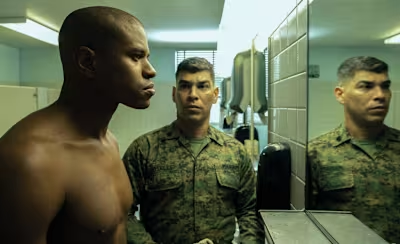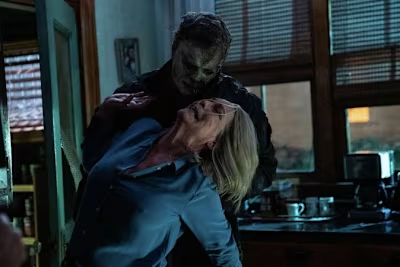From Britney to Basquiat to Sandler to Chappelle: How Tamra Dav…

Tamra Davis courtesy of Netflix
Talk of cult classics usually involves midnight movies, predominantly directed by men. So how do Billy Madison, CB4, Half Baked, and Crossroads stand out from the usual suspects? Three are comedies, one is a coming-of-age drama about young women, and Tamra Davis directed all four.
Most filmmakers are lucky to have one memorable film, much less four. Yet Davis is an underappreciated American filmmaker, even though her work has helped shape American culture for nearly 40 years.
Davis began her career making music videos for Depeche Mode, The Smiths, Sonic Youth, Beastie Boys, the infamous Beavis & Butthead music video with Cher, and Hanson’s two hit videos for MMMBop and Where’s the Love.
She moved into moviemaking with 1992’s Guncrazy, inspired by the 1950 film Gun Crazy. Then Davis followed up her debut with movies starring Adam Sandler, Chris Rock, Dave Chappelle, and Britney Spears.
“I fell into making three comedies at Universal with Rock, Chappelle and Sandler,” says Davis. “To this day, the most important comedians of our time.”
In the last decade, Davis, like many directors, moved into TV, directing episodes of Grey’s Anatomy, Ugly Betty, and P-Valley.
Despite her impact on American culture, Davis still has many untapped stories to tell. She lived through Hollywood’s entire Harvey Weinstein-era, and now she’s one of the industry’s few female directors from that era still working.
“I think without people like myself and some of the early female directors that stood out there and said, “I’m here. You can’t say no,” we paved the way for all these incredible voices that we see today,” says Davis.
MovieMaker spoke with Davis on the occasion of her new movie 13: The Musical coming to Netflix — her first movie since 2006’s A Conversation with Basquiat. The movie is based on the Broadway musical and follows Evan Goldman (Eli Golden), who moves from NYC to small-town Indiana after his parents’ divorce. As his 13th birthday nears, Evan must master the complex social circles of his new school and win friends by turning his Bar Mitzvah into the coolest party his new town has ever seen.
In our conversation, Davis talks about how the pandemic made casting teenagers for 13: The Musical especially difficult — puberty aged her actors faster than she could film them. She also talks about how directing music videos prepared her to direct features and how tough it was to direct Cher in her Beavis & Butthead music video. Davis also tells us how the Harvey Weinstein era made her a stronger artist, and how her friendship with Jean-Michel Basquiat shaped her life and work.

13 The Musical, directed by Tamra Davis. (L to R) Ramon Reed as Eddie, Frankie McNellis as Lucy, Eli Golden as Evan, Shechinah Mpumlwana as Cassie, Gabriella Uhl as Patrice, Khiyla Aynne as Charlotte, and Luke Islam as Carlos: Alan Markfield/Netflix.
Joshua Encinias: 13: The Musical was announced before the pandemic took hold. How did it affect your production?
Tamra Davis: We definitely put it on hold for six months to a year until things straightened out with on-set Covid procedures. It gave us time to make the script stronger. But it also meant that I had to wait before casting because the kids that I was considering got older! And I mean, we were shooting a musical during a pandemic, which was insanity. One of the first things they told me is, “The kids can sing on set, but they have to be surrounded by plexiglass.” And I’m like, “You’re kidding me. I have twenty-two kids coming down the street, do you think they’re all going to be surrounded in a plexiglass bubble?” The amount of restrictions we had to go through in order to make the movie were crazy, but we were also determined and able to make it happen.
Joshua Encinias: Before making High School Musical: The Musical – The Series and 13: The Musical, you made videos for The Smiths, Depeche Mode, Sonic Youth, Hanson, and of course, The Beastie Boys. You went to film school in the 1980s and then made music videos for about 10 years straight. What drew you in that direction?
Tamra Davis: After film school, I wanted to make a movie. At that time, I was almost laughed at sitting in meetings with producers and executives, but I was ready. Even at 26, still nobody was looking for a woman to direct in Hollywood. It was disheartening. I wanted to make a movie and the movie I wanted to make was Guncrazy. I had some bands that I wanted on my soundtrack, and I made a video for one of those bands. The record company called me in to talk about the video and I thought I was in trouble because I didn’t ask for permission. I did it on my own with school equipment from L.A. City College. Then the president of the record company said, “This is amazing, we want you to make a video for us for this other band. We’ll give you $75,000.” So I immediately became a music video director. And it was at the greatest time, because MTV could care less if I was a woman or whatever. I had a cool style and I started working.
Joshua Encinias: How was your experience making music videos?
Tamra Davis: I had the most incredible time. I loved it and met so many amazing people. But I also learned my trade. I learned how to direct, I learned how to work with talent, I learned what I could do on set in a day. I would save up my money from the videos and make short films, so I had narrative skills. I also still tried to have people to invest in my movie. Finally, when I got that to happen, I got Guncrazy made. That was my first feature and I was so happy, in a way, that I had that time to develop my skills by making music videos.
Joshua Encinias: You mentioned being dismissed because Hollywood wasn’t looking for women to direct movies. When your opportunity to direct features came, it overlapped with Hollywood’s Harvey Weinstein era. Have you experienced discrimination or harassment?
Tamra Davis: I definitely feel that the odds were stacked against me at that time. But I was very determined and ambitious, and I felt the “No”s would only make me stronger. I didn’t listen to the “no”s. It definitely was a challenging time, but to have gone through the struggle to direct, I’m so happy to have stretched it out for all these years because I’m happy with where things are now. When I work on TV shows, half of them are directed by women. The opportunities we have now make it such a different field for women. I’m so grateful that things really changed. I think without people like myself and some of the early female directors that stood out there and said, “I’m here. You can’t say no,” we paved the way for all these incredible voices that we see today.
Guillermo Díaz, Dave Chappelle and Jim Breuer in Half Baked, directed by Tamra Davis
Joshua Encinias: After Guncrazy, you would go from making a movies to music videos and back. Can you talk about collaborating with Cher and Mike Judge in 1993 to make their version of “I Got You Babe” with Beavis And Butt-Head?
Tamra Davis: My videos were very prominent on MTV, so I had a good relationship with the folks over there. I was so excited when this job came up. It was fun because my initial calls with Mike Judge were over the phone, and he’s the voice of Beavis and Butthead. So it felt like I was working with those characters when we came up with concepts. That was such a thrill for me, I thought it was so funny. And then Cher was amazing. I’m such a huge fan… what an icon, what an amazing person! She’s also pretty tough to work with, but I had a really good time with her. We figured things out together and in the end, she was super happy with the work that I did. But she was challenging. I was shooting her against these backdrops and the hardest thing in those days was shooting on green screen. She had curly hair and reflective surfaces on her clothes, and she would be like, “This is how it is. Get used to it.” So that phrase became the catchphrase in my life for a while. … I got to work with Bill Pope as my cinematographer, who is amazing.
Joshua Encinias: The movie you made after that was Billy Madison. I read you got the job after the original director was let go. How did you get up to speed and course correct the movie so quickly?
Tamra Davis: I flew out on a Thursday with the president of Universal and I knew Adam’s work already. Universal originally wanted me to direct it because I did CB4 for them and they were really happy with that. So I went out there and I spent the entire first weekend with Tim Herlihy and Adam’s crew. I immersed myself in Adam Sandler’s world because I wanted to really understand his humor and his writing. That’s where being a girl is actually helpful, because comedians love to make girls laugh. So this whole shift happened, the whole dynamic change. Before then, Adam was so stressed that his back and neck went out. He couldn’t move. All of a sudden there was a wave of relief with him relaxing and having fun and making us laugh. I added color to the scenes and I had fun. I was like, “Okay, let’s turn this around. Let’s have a great time.” I had a really good producer on that, Robert Simonds, and Bob was such a supporter of Adam and the film. He really helped smooth everything over.
Joshua Encinias: How was working with Adam?
Tamra Davis: He would call the night before filming and say, “Okay, Tamra, I want you to deflate the balls because I’m really going to hit the kids during soccer.” And I’d be like, “Oh, that’s funny Adam,” and he wouId say, “I’m really going to hit these kids.” I think the whole time he was thinking, “How can I make her laugh? What is she going to do?” It was so fun. I laughed so hard making that film and I think that came across, because the audiences enjoyed it, too.

Joshua Encinias: In CB4 and Billy Madison, each scene feels like a sketch. Is that how you approach directing comedy?
Tamra Davis: It’s interesting because it was kind of like we were reinventing the comedy style. We came after Bill Murray movies which had a very specific style. And yet Adam, Chris Rock and myself, a lot of our comedy is like the sketch comedy you see on SNL. I remember working with Chris and being like, “Every scene has to be so funny.” If we’re in the scene and there’s a joke under the table, we’re going under the table for the joke. We treated every opportunity as a chance to get a comedic moment out of those scenes. We took some of that feel from SNL, where sketch comedy started to blend with narrative comedy. It created that style that wasn’t as narrative driven as the traditional comedies. We broke that mold and made it possible to put comedy first.
Joshua Encinias: I think I’ve seen your movie Half Baked a hundred times, but never in one sitting.
Tamra Davis: That’s how I felt like I’ve seen it. It was crazy that I fell into making those three comedies at Universal with the three, to this day, most important comedians of our time. It was all their first films, it was all their first starring roles. We were really developing comedy styles at that time, who their character was; stretching and bending and pushing it. I was so incredibly lucky to be there at the right place at the right time. But also, I feel that the freedom that those performers had on the sets that we created helped develop them and gave them confidence as well. We also gave them great experiences. We had such great times on those films that I can’t believe, when I look back, at how much we laughed and what we created. None of us knew what we were doing. We were just having a good time.
Josh Encinias: Do you think Charlie Chaplin’s quote, “Life is a tragedy when seen in close-up, but a comedy in long-shot,” is an accurate summary of how dramas vs comedies are filmed?
Tamra Davis: I really like to think of color in comedy. It’s hard to make a comedy cinematically when the color’s really dull. Comedies usually have a more realistic feel so if you pop the colors out, that really helps. Where to put the camera for the comedy is really important. I remember sitting with Adam, we would construct a scene, and we would discuss where the camera should go to tell the joke, because the camera is also telling the punchline. You have to make sure the camera is set up in the right spot to reveal the joke or to tell the joke, so we would walk around a scene and try to figure out where to place it. There’s also a rhythm to comedy. A lot of it is how the joke should be said. Sometimes comedians are so supremely talented that they immediately know how to tell it. Adam was so helpful. Sometimes he would almost sing the way it should be in my ear. So once I heard what the jokes should sound like, I could get that same performance out of the actor. So a lot of it is a rhythm. I think comedy is magical in a way. When it comes together and all of a sudden you laugh, you’re like, “Where did that come from?” It’s such a magical, ethereal place that a simple few lines on a script, told the right way by the right people, can make you laugh. The same words could make you cry. So there’s an art and magic to it. It’s a symbiotic relationship between all these elements from the actor’s performance — but also where I put the camera, how I lit it, and styled it, and the rhythm of the joke.
Joshua Encinias: How does it feel that CB4, Billy Madison, Half Baked, and Crossroads are certifiably cult classics, even though they were panned by critics upon release?
Tamra Davis: Whenever you make a movie, you want everybody to love and enjoy it. When anybody says anything negative about your movie, of course, those things stick out to you. Adam and I got together after critics really trashed Billy Madison and we realized that if we made the critics happy on this movie, then we fucked up, that we failed. Because our audience hated the critics at that time, they were anti-critic. They didn’t like the movies that the critics liked. I didn’t make the movie for Roger Ebert. Whereas my movie Guncrazy, that was critically acclaimed. But Billy Madison was for Adam’s fans. When we screened it for his fans, they loved it. I realized that as long as I made the right movie for the audience that I was intending, my film was a success, and I had to ignore critics. You get tough skin with that, and say, “I wish they loved it.” As long as Adam and his core audience loved it, then I felt like I did a great job. So I was fine after seeing bad reviews. It didn’t take me down. But criticism like that can take a filmmaker down.
Joshua Encinias: You knew Basquiat while you were in film school and turned a recording of him into the documentary Jean-Michel Basquiat: The Radiant Child. How did your friendship with Basquiat shape you as an artist?
Tamra Davis: When we hung out in those early days, we were such dreamers. I totally believed that I was going to be a filmmaker and he totally believed that he was going to be a big artist. But we were these fringe characters that nobody would take seriously. I think that really bonded us because he was to the art world as I was to the movie world. We were on the outside of the club trying to get in and thought that we deserve to be part of that membership. He was incredibly ambitious and had so much confidence in the early days, and it was the same with me. I feel like we co-inspired each other in a way, and I loved that in my relationship with him. It also pained me that he was an artist that was very sensitive to criticism, and he wanted to get that ultimate acceptance and approval. When you’re a sensitive artist and they’re trashing you and tearing you down, it can have a very negative effect. It could actually lead to mental problems. It was harder for him to control those critical voices in his head. And I totally get it, so that was part of why I wanted to make a movie that showed an artist is sensitive. Especially to this incredible amount of criticism he received … I wish he was here to see his success.
Joshua Encinias: Netflix released The Andy Warhol Diaries earlier this year and the last section of the docuseries is about his relationship with Basquiat. Did you see it, and did you know Warhol during that time?
Tamra Davis: I don’t think I saw it. Oh, my gosh, I have to go back and look at it. I knew Andy during that time and we definitely went to dinners. Jean-Michel stayed in Andy’s studio and I saw Andy a bunch during that time. It was a very interesting and complicated relationship. I think I really explored it in my film — how Andy became a father figure for Jean-Michel. He also told me that if he could tie himself closer to Andy, that he would finally get the acceptance he wants. It’s like if I made a movie with James Cameron or Steven Spielberg, I would think, finally, I’m accepted into the world. Instead, if I did it, everybody would say, “She’s the lapdog of Steven Spielberg.” That’s what they said to Jean-Michel. Instead of saying he finally made it, they just trashed him again. Andy really tried to help Jean-Michel. He was a positive person in Jean-Michel’s life, but I don’t think he could reach Jean-Michel at the time.
Main Image: Tamra Davis courtesTamra Davis courtesy of Netflixy of Netflix
Share:
Like this project
Posted Sep 22, 2023
13: The Musical director Tamra Davis has directed iconic films, and worked with everyone from Britney to Basquiat to Sandler to Chappelle to Cher.
Likes
0
Views
44





